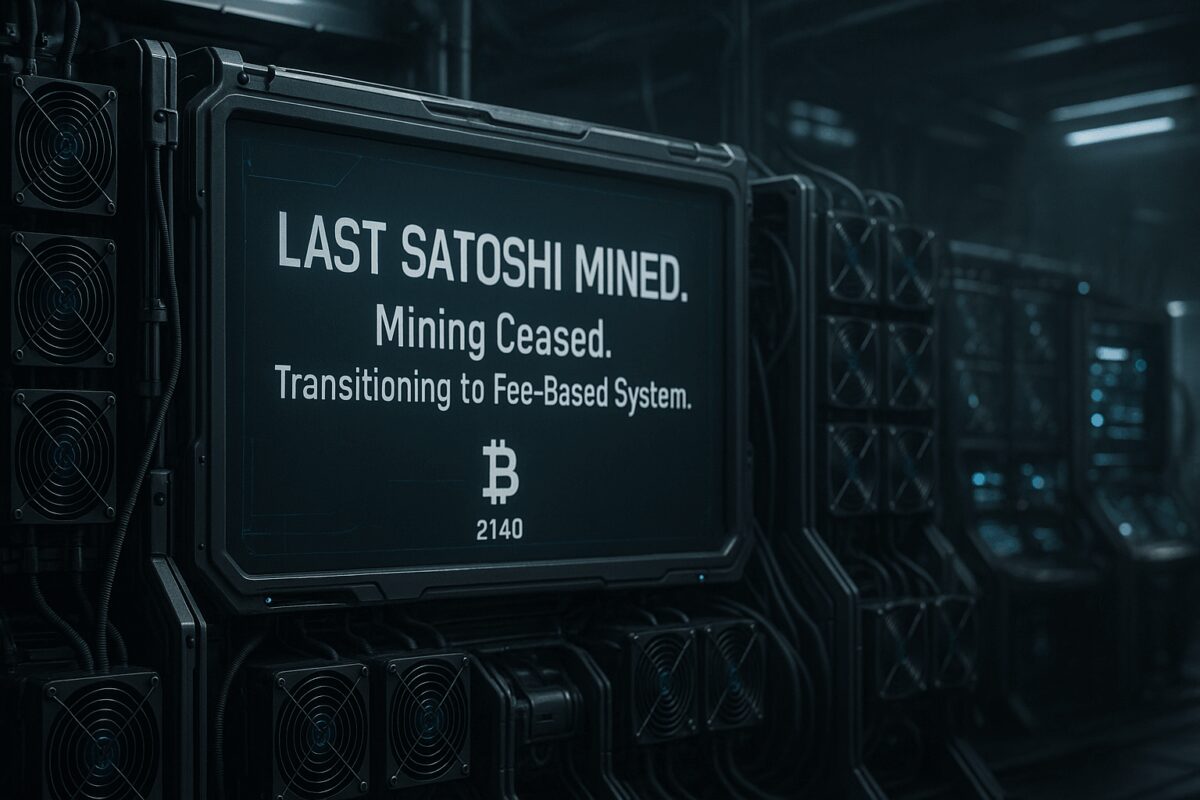
When will the last Bitcoin be mined, and what happens after that? Sometime around 2140, the very last new sliver of Bitcoin will, according to current understanding, be brought into existence through mining. This isn’t a random guess; Bitcoin’s own unchangeable math sets this endpoint by carefully managing how many coins there can be and how quickly they’re created. We’re going to look at how Bitcoin’s limited amount works, what happens as fewer new coins get made, and what the world might look like once no more fresh Bitcoin can be mined.
Bitcoin’s DNA: A Set Limit and How New Coins Emerge
Bitcoin’s entire money system revolves around a strict, unalterable ceiling: only 21 million coins will ever exist. Satoshi Nakamoto, the mysterious mind(s) behind Bitcoin, built in this scarcity on purpose, hoping to sidestep inflation and make Bitcoin different from regular money, which governments can print more of whenever they choose. In old emails with early Bitcoin helper Martti Malmi, Satoshi mentioned that 21 million felt like a sensible number, one that could make Bitcoin prices easy to grasp if lots of people started using it, while its ability to be split into tiny pieces (down to one “satoshi,” or 0.00000001 BTC) meant you could still make small payments even if one Bitcoin became very valuable.
Interestingly, because of how Bitcoin’s programming handles rounding, the final tally of all Bitcoins might actually be a tiny bit less than 21 million—perhaps closer to 20,999,999.9769 BTC. Still, for everyone talking about Bitcoin, 21 million is the number everyone agrees on.
New Bitcoins get into our hands through “block rewards.” People called miners use powerful computers to check and confirm transactions, bundling them into new “blocks” on the Bitcoin blockchain; for this work, they receive a fresh batch of BTC. Back when Bitcoin first appeared in 2009, miners got 50 BTC for each block.
A really important part of this system is something called the “halving.” It’s built right into Bitcoin’s rules: every 210,000 blocks, the reward for miners gets cut in half. Since the network aims to create a new block about every 10 minutes, these halvings happen roughly every four years. This slow, steady chop to the reward ensures new Bitcoin creation slows down in a predictable way as we get closer to that 21 million coin total.
Moments the Reward Shrank:
- November 28, 2012: The reward dropped from 50 BTC to 25 BTC.
- July 9, 2016: It went from 25 BTC down to 12.5 BTC.
- May 11, 2020: Miners then saw rewards fall from 12.5 BTC to 6.25 BTC.
- April 19/20, 2024: The most recent cut took the reward from 6.25 BTC to 3.125 BTC.
The 2140 prediction for the last Bitcoin comes from simply following this halving pattern out. As the block reward keeps getting smaller and smaller, it will eventually become less than a single satoshi, making the reward effectively nothing.
Inch by Inch to the Max: How Time and Blocks Play Out
Even though 2140 is the year new Bitcoin creation is set to stop, most of the coins will be out in the world long before then. Take 2032, for example; by that year, about 98% of all possible Bitcoins are expected to have been mined. As of May 2024, miners had already unearthed around 19.7 million Bitcoins, which means only about 1.3 million BTC were still waiting to be found, down from roughly 1.5 million noted earlier in 2024.
The exact day of a halving, or even when that final coin is mined, can shift a little bit based on how fast blocks are actually made. Bitcoin’s system tries to keep new blocks appearing every 10 minutes by adjusting how hard it is to mine them about every two weeks (or 2,016 blocks). But, if the total computer power on the network (the hash rate) changes a lot, blocks might come out faster or slower than 10 minutes for a while. If blocks are found quicker than planned for long stretches, halvings could arrive a bit early; if they’re slower, halvings get pushed back. These little shifts, adding up over many years, mean that while 2140 is a solid forecast, there’s a little bit of wiggle room.
After the Last Coin: Transaction Fees Take Over
When that very last Bitcoin has been mined, what motivates miners will change completely. They won’t get block rewards anymore. Instead, their main pay will come entirely from transaction fees, which are small amounts people pay to get their Bitcoin transactions processed and included in a block. Satoshi Nakamoto saw this coming, writing in the original Bitcoin plan that “once a predetermined number of coins have entered circulation, the incentive can transition entirely to transaction fees and be completely inflation free.”
This switch to fee-only income is a big point of discussion about Bitcoin’s “security budget”—basically, how much money is available to pay miners. The main worry is whether transaction fees alone will be enough to keep miners interested and the network powerful enough to fend off major attacks, especially if Bitcoin becomes incredibly valuable.
Some people think that as more people use Bitcoin and make transactions directly on the blockchain, a healthy market for fees will just naturally develop. If more people want to use the limited space in each block, perhaps spurred by new things like Ordinals, that should generate enough money from fees. Even things like the Lightning Network, which handles many payments off the main blockchain, still need to use the main chain for big settlements, and that could add to the fee income.
Others aren’t so sure, worrying that there won’t be enough transactions, that fees will swing wildly up and down, or that miners might just quit if it’s not profitable enough. If that happens, the network could become less secure or controlled by just a few big mining companies. There’s also a “tragedy of the commons” fear: people who just hold Bitcoin for a long time benefit from a secure network but might not pay their fair share through transaction fees.
Rewards Dwindle: Mining Changes Shape
As block rewards get smaller and smaller, it really shakes up how miners operate, how much money they can make, when they buy new equipment, and even where in the world they set up shop.
- How Miners Adapt: Miners have no choice but to get as efficient as possible. This means buying the newest, most power-saving ASIC machines, cutting down on electricity use (they’d need to aim for power around or under $0.05 per kilowatt-hour for top-tier ASICs by early 2025 to stay in the black), and maybe finding other ways to make money. When new Bitcoin-based systems like Runes appeared in April 2024 and caused transaction fees to skyrocket for a bit, it showed how vital fee income is becoming and gave miners a temporary cash infusion.
- Squeezed Profits: Every time a halving happens, making money gets harder. The price of Bitcoin, how much computing power is on the network, changes to mining difficulty, and electricity prices all become super important for a miner’s survival. The hashprice, which is how much a miner earns per unit of computing power each day, took a big hit by April 2025, right after the 2024 halving, really driving this point home.
- Equipment Upgrades: The race for better efficiency makes old mining gear obsolete faster. Miners have to keep buying newer ASIC models, which fuels demand for cutting-edge computer chips (like 3-nanometer and 2-nanometer ones) and smart ways to keep machines cool.
- Where Mining Happens: Miners chase cheap electricity and friendly government rules. Right now, the United States, especially Texas, has the biggest share of the world’s mining power (around 38-40% in early 2025). China (even with its bans), Kazakhstan, Canada, and Russia are also big. New places like Paraguay and Iceland are starting to attract miners too. Big-picture politics, like Russia thinking about using mining within the BRICS group of countries to possibly get around economic sanctions, makes things even more complicated.
Rarity, Feelings, and Money Matters
The idea that Bitcoin has a strict limit is a big part of how people feel about it and how investors think. The “digital gold” nickname really clicks with people, especially as we get closer to that 21 million coin cap, creating excitement and sometimes a fear of missing out (FOMO). Lately, it seems most people are positive about Bitcoin, with medium-sized investors steadily buying more, and big financial companies getting more interested after the U.S. allowed Bitcoin spot ETFs.
When all Bitcoins are finally mined, it’s expected to have some major effects on its economics:
- Price: If no new coins are being made, how much people want Bitcoin will be the main thing setting its price. If demand stays strong or grows for something that’s truly rare, most people expect Bitcoin’s price to go up.
- Total Value: This is just the price multiplied by the number of coins, so it would grow if the price does.
- Trading Availability: Since miners won’t be regularly selling brand new Bitcoins, how easy it is to buy or sell will depend on whether current owners want to trade. If most people are just “hodling” (holding long-term), there might be less Bitcoin available for quick trades.
- Price Swings: Some think a mature Bitcoin with no new supply might be less jumpy in price, but big surprises in demand could still cause big price moves. If more large institutions get involved, though, that might make the markets deeper and possibly calm things down over time.
This limited supply also keeps alive the discussion about whether Bitcoin will mostly be a way to store wealth (like “digital gold”) or if it can also be used for everyday buying and selling. Because it’s designed to become more valuable over time (deflationary), people might be less likely to spend it. Problems with handling lots of transactions on its main network, which can lead to high fees when it’s busy, also make it tricky for daily purchases, highlighting why systems built on top of Bitcoin, like the Lightning Network (Layer 2 solutions), are so important. These secondary systems try to make transactions faster and cheaper, so Bitcoin could be more useful day-to-day, with the main network still keeping everything secure.
The Green Debate and Tech’s Path Forward
How much energy Bitcoin mining uses is still a hot topic. When miners have to rely only on fees, there might be even more pressure to use less energy and switch to renewable sources. Some miners already use things like leftover natural gas or green energy, but what’s cheapest will probably always be the main factor.
New inventions will keep changing Bitcoin’s path:
- Better ASICs: We’ll likely see ongoing improvements making mining machines more powerful but using less electricity, which is key for miners to stay profitable when they only earn fees.
- New Energy Sources: The need for cheap power will probably keep pushing miners to find sustainable and different kinds of energy.
- Quantum Computers: These super-powerful future computers are a distant worry for Bitcoin’s current security codes. The Bitcoin community is already looking into new types of encryption that quantum computers can’t break, to keep the network safe far down the road. If Bitcoin doesn’t switch to quantum-proof methods before these computers become a real problem, the whole network could be at risk.
Who’s in Charge and Staying Secure After New Coins Stop?
When block rewards stop around 2140, how Bitcoin is managed will change. If miners only earn transaction fees, making sure they still want to protect the network will be incredibly important. Developers have talked about some very long-term ideas, like maybe having a tiny, never-ending block reward (called “tail emission”) after 2140, or even a system that charges a small fee on Bitcoins that haven’t been moved in a long time (“demurrage”). But these ideas are really controversial because they’d change fundamental things about Bitcoin, especially its 21 million coin limit, and getting everyone to agree on such big changes is almost impossible. For now, people are focused on making the current fee system work better and improving those Layer 2 solutions.
All the “lost Bitcoins”—coins that can never be used again because people lost their private keys—make the existing supply even scarcer. People guess that millions of BTC are gone forever, which means there are fewer actual coins in circulation, and that could make the ones that are left even more valuable.
Wrapping Up: A Future Built on Finite Supply
It’s a long road until the last Bitcoin is mined, but because its creation is all planned out, it gives us a really interesting look at how digital rarity works. As the rewards for mining shrink and then disappear, the Bitcoin network will have to run entirely on transaction fees to pay miners and keep itself secure. This big shift, along with new technologies always popping up, changing government rules, and how people feel about the market, will all shape what Bitcoin ultimately becomes in the world of money. There will definitely be bumps in the road, but the basic idea of a limited, predictable supply is still a huge part of Bitcoin’s story and its future possibilities.




